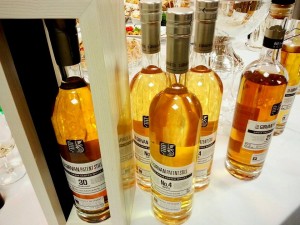With the Grain
All photos by Keith Allison.
For a market that has always been about tradition, the modern whisky landscape sure does demand a lot of innovation. Chalk it up to our decreased attention span if you are gloomy, or our questing hunger for new experience in a world that is open and accessible like never before, if like me you are more positive. In the United States, hamstrung by rules about barrels, distillers have started experimenting with the mashbill -- substituting new and unique grains like millet or quinoa or oats in place of the traditional quartet of corn, barley, rye, and wheat. In Scotland, the opposite is true. Scotch can only be made from malted barley, but you can tweak your product by using barrels that previously contained anything from bourbon to sherry to Cognac to pickled herring (the last one...not so in demand).
But the hunger for something new -- and the shortage of aged whisky in both the US and Scotland -- means consumers are asking, “what’s new?” even in the face of these innovations. It would seem the next wave, as an answer to both the unquenchable thirst for something new and the shortage of aged bourbon and Scotch, is to start promoting a new class of spirit: single grain whisky.
OK, so it’s not actually new, and exactly what it is can be confusing. After all, isn’t single malt Scotch made from a single grain, that grain being malted barley? Yes, which is why single grain is loosely defined as “any grain but malted barley.” That includes unmalted barley. And how does single grain differ from “neutral grain,” the spirit that comes off a column still in bulk and is used to make blended Scotch whisky? Well, the primary difference there is that neutral grain is distilled and filtered to remove the flavor -- Scottish vodka, some call it -- while single grain is intended to have flavor, color, and character. Single grain is also made using a column still, rather than the traditional pot still used in the production of single malt. And while it may not be new, its position as a product distillers and blenders are pushing in the market is something that has only recently started to gain traction.
William Grant & Sons, owners of the single malts Glenfiddich and Balvenie, recently launched Girvan, a new line of single grain whiskies, most of them bearing an age statement and all of which were made available in a tasting room this past July at the 2014 Tales of the Cocktail and named in honor of the Girvan Distillery, the construction of which was overseen by William Grant's great-grandson, Charles Gordon, in 1963. It was not my first experience with single grain whisky, and it isn’t the first high profile single grain product on the market. Ireland’s Greenore makes a lovely single grain whisky, as does Japan’s Nikka with their Coffey Grain (as their previous Single Coffey Malt). Compass Box makes Hedonism, a blend of several different single grain whiskies, and independent bottlers have previously released old, amazing single grain whisky, like Scotts Selection’s North of Scotland and Invergordon.
With Girvan, however, William Grant & Sons is aiming for something a little different. An entire line of single grain whisky meant to punch at the same level as single malts (and, presumably, take some of the pressure off the single malt shortages) is new. The first product in the Girvan line, a 25 year old whisky aged primarily in ex-bourbon casks (with some sherry and new oak) and bottled at 42% ABV was released last November in the UK. The 25 year old, along with subsequent releases that include a 30 year old expression and one bearing no age statement known as “No 4 Apps” (in honor of the still on which it was made) are scheduled for US release in fall of 2014. Although I don’t like to be the “older is better” sort of chap, the fact is both the 25 and 30 year old whiskies were exceptional. Buttery, waxy, with just the right amount of oak. There’s a hint of peaches and cream, of vanilla, with a spiciness that makes a brief appearance but doesn’t stick around for you to get to know it. The no-age-statement No 4 Apps is sharper and more viscous, with more intense floral notes muscling out the more prominent cream of the older expressions.
If there is anything standing in the way of the Girvan Patent Still line, it’s the cost. Not surprisingly, both the 25 and 30 will carry heavy price tags, placing them out of the reach of most consumers and making them a risky prospect even for more monied drinkers, who might be unwilling to spend hundreds of dollars on an unfamiliar product. Even the price of the No 4 Apps is going to push the envelope. Considering that consumers can buy established Greenore or Hedonism for a similar, or lower, price, it remains to be seen whether William Grant & Sons can convince people to pay extra-premium prices for a type of whisky they might never have heard of.
There are already several brands, including venerable Cameron Brig and the recent Snow Grouse (a blended grain whisky from Famous Grouse), available in the UK market, and Diageo recently revived the old Haig brand and applied it to Haig Club, a single grain unveiled amidst a massive PR campaign featuring David Beckham. The price point of the brands being imported to the US might prove prohibitively high, but chances are, if they can create buzz, more inexpensive single grain options will start to emerge. Whatever the case, it seems that Scottish whisky made from grains besides malted barley is going to emerge in the US as a player in the coming months and years.



